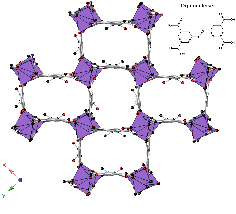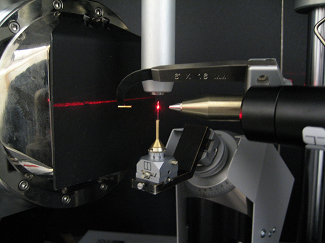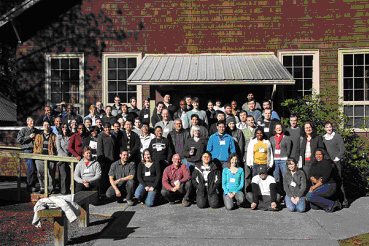The NMHU in association with MC established a formal alliance with the STC “Materials and devices for information technology research” – MDITR - (UW, UA and GIT) in 2009. Project participants collaborated in area of photonic materials for more than 5 years. NSF PREM funding will allow them to significantly increase number of underrepresented students directly involved in modern research in Material Sciences via the development of a project “Light-Matter Interactions – Theory and Applications” (LMITA).
The goal of LMITA-PREM project is to develop a multidisciplinary multi-university program in Materials Science that will give broad access for students to modern areas of transformative research, including high-level technologies for materials and device fabrication and characterization of materials using facilities and theoretical approaches existing at all participating institutions. LMITA-PREM includes three thrusts:
 Metal organic framework with luminescent properties.
Metal organic framework with luminescent properties.
Research Thrust 1 (David Sammeth and Rodolpho Martinez, NMHU, in collaboration with Joe Perry and Joel Hales, GIT) includes design, synthesis and spectroscopic characterization of material for potential applications in bioimaging and two-photon photodynamic therapy. Recently we identified a group of anticancer materials that can be easily converted into light-sensitive materials by the substitution of acceptor with donor groups. Sensitivity to light and near-IR radiation allows using these materials as fluorescent markers and photosensitizers for one- and two-photon photodynamic cancer therapy. The advantage of two-photon therapy is deeper penetration of radiation that is not as harmful as radioactive treatment, and in some cases can help avoid surgery. An outside collaborator in this project is the Russian Academy of Sciences, where portions of the synthesis and bioassays are carried out.
Research Thrust 2 (Mikhail Antipin, Jennifer Lindline and Tatiana Timofeeva, NMHU, and Jean-Luc Brédas, Stephen Barlow, Veaceslav Coropceanu, and Seth Marder, GIT) concentrate their efforts on the synthesis and structural (diffractional and computational) characterization of materials for nonlinear optical and electrooptical applications. We are exploring new approach to NLO materials via creation of acentric coordination polymers or metal-organic frameworks (MOFs). MOFs, due to their porous structure, can also be used as gas-storage materials and/or fluorescent sensors. Outside collaborators for this portion of the project are Sandia and Los Alamos National Labs, located close to NMHU.
 X-ray diffractometer equipped with laser system for crystal growth.
X-ray diffractometer equipped with laser system for crystal growth.
Recently it was found that organic NLO materials can generate THz radiation. Our group is studying such materials using an experimental diffraction approach that, in general, can give information on charge distribution of similar quality to that obtained through quantum-chemical computations. An advantage of this approach is that we can obtain, in contrast with typical computational studies of the gas phase, characteristics of molecular properties in the crystalline environment, along with energy of intermolecular interactions, charge distribution in crystals, molecular dipole moments and their relative orientations. All of these characteristics, accompanied by quantum-chemical computations, allow for better understanding of nature of the above mentioned effect.
Research Thrust 3 is devoted to development of pathways for synthesis of materials for photovoltaic elements, i.e., organic solar cells (Brian Lawrence, MC, Seth Marder, GIT, and Rodolpho Martinez, NMHU). Successful developments in this area might lead to industrial connections useful for future employment of PREM students.
 MDITR annual Retreat near Seattle with participation of PREM students and professors.
MDITR annual Retreat near Seattle with participation of PREM students and professors.
Educational Activities
At present the PREM program supports 8 undergraduate and 6 graduate students at NMHU. Two undergraduate students are supported by PREM at MC. Two high school teachers were identified for participation in summer program at NMHU and 5 undergraduate students submitted applications for summer REU programs at UW and UCF. A laboratory course on fabrication of holograms for science, math and art students was implemented during this semester at NMHU (Gil Gallegos).
PREM Highlights
PREM students presented five posters at regional ACS meeting at El Paso, November 2009, two posters at MDITR Annual Retreat, February 2010, and prepared two posters for the 9th International Symposium on Functional π-Electron Systems, Atlanta, May 2010. Several lectures will be given for PREM students in April by experts in the synthesis, characterization and applications of photonic materials. The NMHU PREM website was created by Computer Science graduate students under supervision of Gil Gallegos.
Selected Publications
- R. Sánchez-Carrera, S. A. Odom, T. L. Kinnibrugh, T. Sajoto, E.-G. Kim, T. V. Timofeeva, S.Barlow, V. Coropceanu, S. R. Marder, J.-L. Brédas. “Electronic Properties of the 2,6-Diiododithieno[3,2-b:2′,3′-d]thiophene Molecule and Crystal: A Joint Experimental and Theoretical Study”, J. Phys. Chem. B, 2010, 114, 749–755.
- R. Zou, A. I. Abdel-Fattah, H. Xu, A. K. Burrell, T. E. Larson, T. M. McCleskey, Q. Wei, M. T. Janicke, D. D. Hickmott, T. V. Timofeeva, Y. Zhao, “Porous Metal−Organic Frameworks Containing Alkali-Bridged Two-Fold Interpenetration: Synthesis, Gas Adsorption, and Fluorescence Properties”, Crystal Growth & Design, 2010, 10, 1301–1306.
- A. L. Appleton, S. Miao, S. M. Brombosz, N. J. Berger, S. Barlow, S. R. Marder, B. M. Lawrence, K. I. Hardcastle, U. H. Bunz, “Alkynylated Aceno[2,1,3]thiadiazoles”, Org. Lett., 2009, 11, 5222-5225.
